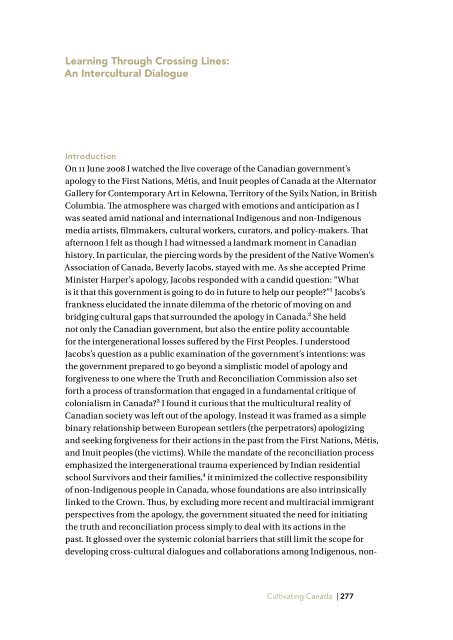Srimoyee Mitra - Speaking My Truth
Srimoyee Mitra - Speaking My Truth
Srimoyee Mitra - Speaking My Truth
- No tags were found...
You also want an ePaper? Increase the reach of your titles
YUMPU automatically turns print PDFs into web optimized ePapers that Google loves.
Learning Through Crossing Lines:An Intercultural DialogueIntroductionOn 11 June 2008 I watched the live coverage of the Canadian government’sapology to the First Nations, Métis, and Inuit peoples of Canada at the AlternatorGallery for Contemporary Art in Kelowna, Territory of the Syilx Nation, in BritishColumbia. The atmosphere was charged with emotions and anticipation as Iwas seated amid national and international Indigenous and non-Indigenousmedia artists, filmmakers, cultural workers, curators, and policy-makers. Thatafternoon I felt as though I had witnessed a landmark moment in Canadianhistory. In particular, the piercing words by the president of the Native Women’sAssociation of Canada, Beverly Jacobs, stayed with me. As she accepted PrimeMinister Harper’s apology, Jacobs responded with a candid question: “Whatis it that this government is going to do in future to help our people?”1 Jacobs’sfrankness elucidated the innate dilemma of the rhetoric of moving on andbridging cultural gaps that surrounded the apology in Canada.2 She heldnot only the Canadian government, but also the entire polity accountablefor the intergenerational losses suffered by the First Peoples. I understoodJacobs’s question as a public examination of the government’s intentions: wasthe government prepared to go beyond a simplistic model of apology andforgiveness to one where the <strong>Truth</strong> and Reconciliation Commission also setforth a process of transformation that engaged in a fundamental critique ofcolonialism in Canada?3 I found it curious that the multicultural reality ofCanadian society was left out of the apology. Instead it was framed as a simplebinary relationship between European settlers (the perpetrators) apologizingand seeking forgiveness for their actions in the past from the First Nations, Métis,and Inuit peoples (the victims). While the mandate of the reconciliation processemphasized the intergenerational trauma experienced by Indian residentialschool Survivors and their families,4 it minimized the collective responsibilityof non-Indigenous people in Canada, whose foundations are also intrinsicallylinked to the Crown. Thus, by excluding more recent and multiracial immigrantperspectives from the apology, the government situated the need for initiatingthe truth and reconciliation process simply to deal with its actions in thepast. It glossed over the systemic colonial barriers that still limit the scope fordeveloping cross-cultural dialogues and collaborations among Indigenous, non-Cultivating Canada | 277
















